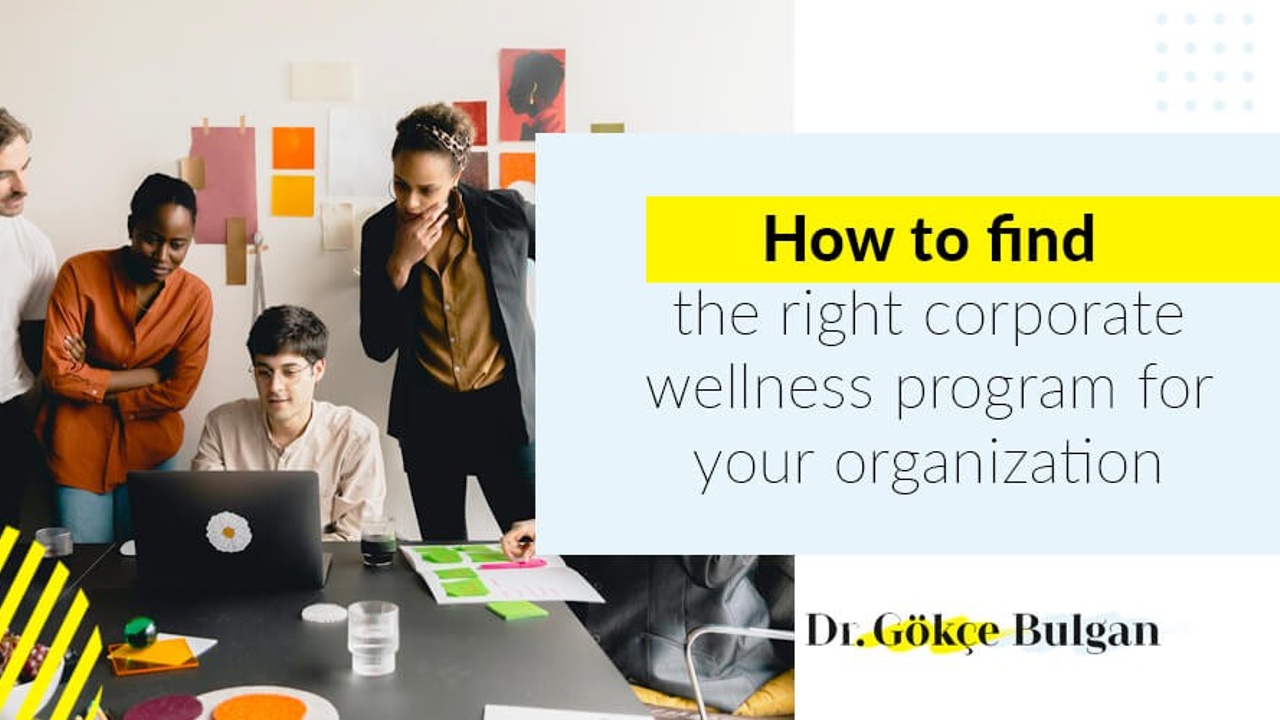How to find the right corporate wellness program for your organization

Corporate wellness programs have become increasingly common in recent years. In a relatively short space of time we’ve gone from a general ignorance of the importance of mental health and well-being programs, to a wide range of happy, productive workplaces embracing wellness programs.
Whilst embracing wellness and well-being in the corporate context is extremely welcome, we’ve ended up in a situation where companies are spoilt for choice when selecting a wellness program.
If you are aware of the importance of well-being in your place of work, that’s already half the battle. But the question still remains: how do you find the right corporate wellness program for your organization?
This guide will help you understand the importance of getting the right wellness program for you, what makes up an effective wellness plan, and how to put it into practice.
Let’s get stuck in.
What is a corporate wellness program?

It’s worth starting with the basics: what exactly is a corporate wellness program? These programs come in all shapes and sizes, but let’s take a look at some of the common characteristics of all effective well-being strategies.
Simply put, a corporate wellness program is a company-wide project that engages employees and management in an ongoing program designed to improve employee well-being and wellness in the workplace.
There’s no one single definition of what constitutes a wellness program, but effectively designed ones tend to have the following characteristics in common:
- They take place over an extended period of time
- Have a coherent structure that facilitates a range of activities
- Involve implementing processes that make tangible changes to the workplace
- Have a strong educational component
- Have company-wide buy-in including upper management and department leaders
- Based on proven strategies, from leadership coaching to neuroscience
- Have been shown to get results in a wide range of corporate settings
- Implemented by certified well-being professionals with relevant experience
By now I hope you have a broad understanding of the key characteristics of corporate wellness programs. This is important information that can help you find the right program for your business. Next up, let’s look at some real-world examples of effective corporate well-being initiatives.
What does an effective corporate wellness program look like?

As we’ve discovered, there is no set definition of what makes up a corporate wellness program. Usually, such programs are designed to fit the specific needs of the company implementing them. And those needs can vary greatly from workplace to workplace.
Here we’ll take a look at three different corporate wellness programs in action, with each taking a different approach to fostering better mental health and emotional well-being.
Inside a Thriving Mind
Fortune 500 IT company Accenture launched their Thriving Mind wellness program in 2020. They partnered with Thrive Global and Stanford Medicine to create a “self-directed learning experience” to empower employees to improve well-being and develop emotional resilience.
With a combination of video learning, action-based goal setting called “Microsteps”, and mindfulness-based approaches to stress reduction, Accenture’s corporate wellness program is designed to “destigmatize the mental health conversation and build mental resilience within the global organization” and has helped engage over 120k employees.
The program draws on scientific research from Stanford Medicine, the positive storytelling platform Thrive, and Accenture’s company-wide emphasis on creating a culture of well-being.
The Intuit approach to well-being
Finance software designers Intuit’s Well-being For Life program offers employees up to $1300 of financial support for any well-being related expenses to help support physical, emotional, or financial well-being. They offer a wide range of support for employees, including access to certified wellness coaches, 1 on 1 therapy sessions, and a range of mindfulness and emotional resilience training resources.
Intuit’s well-being initiatives include offices with state-of-the-art fitness facilities with access to personal trainers, meditation and mindfulness communities, and their cafes and break rooms offer healthy eating options. They also offer financial counseling to support financial well-being and encourage the professional development of their workforce.
Search Inside Yourself with Google
Google are not just market leaders in helping people search online – they also want to help their employees learn to search within themselves to discover hidden resources, and unlock greater well-being.
In 2007 software engineer Chade-Meng Tan brought together a group of leading experts in mindfulness, emotional intelligence, leadership, and neuroscience to develop the Search Inside Yourself (SIY) program. SIY quickly became much in-demand, and by 2012 grew into an independent organization called the Search Inside Yourself Leadership Institute, or SIYLI, irreverently pronounced “silly” (who said emotional intelligence had to be serious?).
Over 100,000 people have participated in the Search Inside Yourself program, across 50 countries.
As a certified SIY facilitator myself, I’ve seen first-hand the kind of amazing transformations the Search Inside Yourself program can bring – both to individuals, and in terms of its impact on team cooperation and increased performance.
How to make your employees happier and healthier
In recent years there have been a wealth of studies showing that happier employees are also more productive, including a 2019 study from Oxford University that showed that happy workers are 13% more productive. And, conversely, unhappy workers are less productive. A study by Warwick University found that workers in a study who had suffered negative events in their lives in the previous year, such as family bereavements, were 10% less productive. According to the research team:
“We find that human happiness has large and positive causal effects on productivity. Positive emotions appear to invigorate human beings […] making workers happier really pays off.”
They site as an example Google’s investment in employee support having led to a 37% increase in employee satisfaction:
“The driving force seems to be that happier workers use the time they have more effectively, increasing the pace at which they can work without sacrificing quality.”
Now that we’ve established the importance of developing a happy and healthy workforce, how exactly do you go about making your employees happier and healthier?
Here are what I have found to be some of the most important ways to create a happy, productive team:
- Set up processes that help you listen to your staff, and be willing to make reasonable changes to support colleagues.
- Take well-being seriously. Champion the value of time-off, sick leave, regular breaks, and personal interests.
- Offer health and wellness benefits like a gym membership, mindfulness sessions, yoga/pilates classes, etc.
- Reward staff for achievement, and offer career development opportunities to prevent career stagnation and demoralization.
- Take active steps to create a positive, open, and inclusive culture that understands the value of taking mental health and well-being seriously.
- Implement a corporate wellness program to create a structure to nurture and support your teams.
With all these points in mind, let’s dive into creating the right well-being program for your workplace.
How can you decide what type of corporate wellness program is right for your business?
Because there is no one size fits all corporate wellness program that’s right for every business, a good starting point is to work out exactly what your organization needs.
Ask yourself what positive changes you want to see. Consider factors like:
- Increased focus and attention to detail
- Frictionless team collaboration
- Conflict-free communication
- Reduced staff stress and anxiety levels
- A more open and inclusive work culture
- Greater emotional intelligence from leaders
- Improved resilience during stressful periods
Once you know what you want to achieve, think about what delivery methods work best for your company.
- Do you want to run virtual workshops and 1:1 mentoring sessions?
- Are you looking for someone to help you overhaul your existing wellness program?
- Do you want to design a bespoke well-being at work program?
If these pointers have helped you decide what sort of well-being program is right for your business, that’s great.
But don’t worry if you are still unsure, or have questions about the right way forward. Sometimes it’s helpful to talk to an expert to help you make up your mind. I love helping teams and individuals unlock their true potential in high-performance workplaces, and I’m always happy to talk to people to help them find the right wellness program for them. Contact me through my site to find out how I can help. I can’t wait to hear from you!

